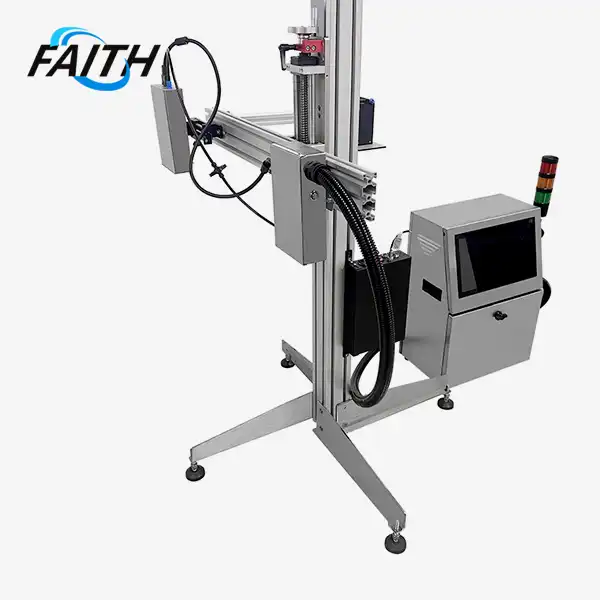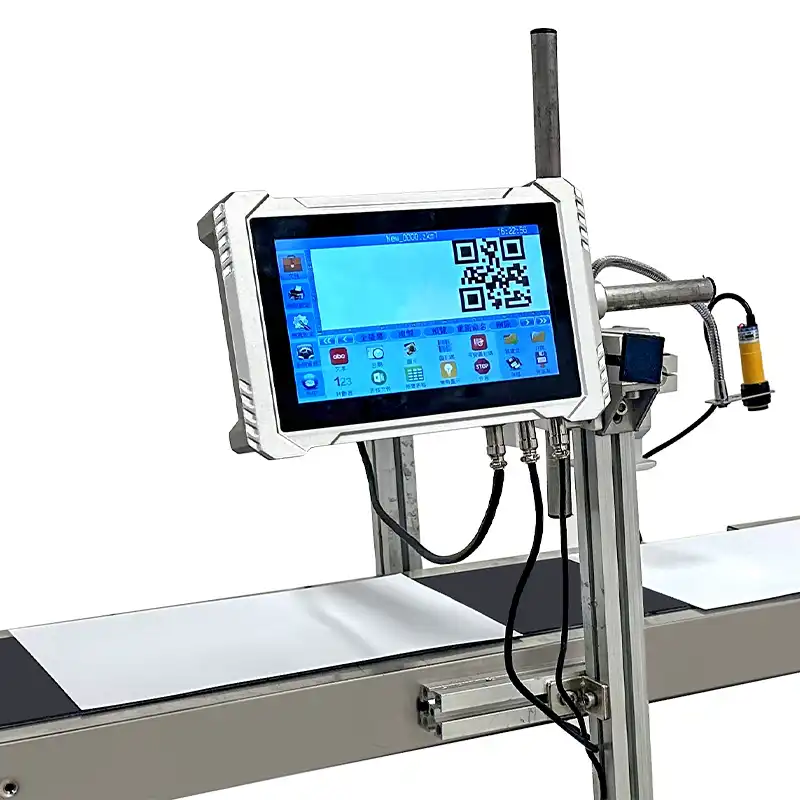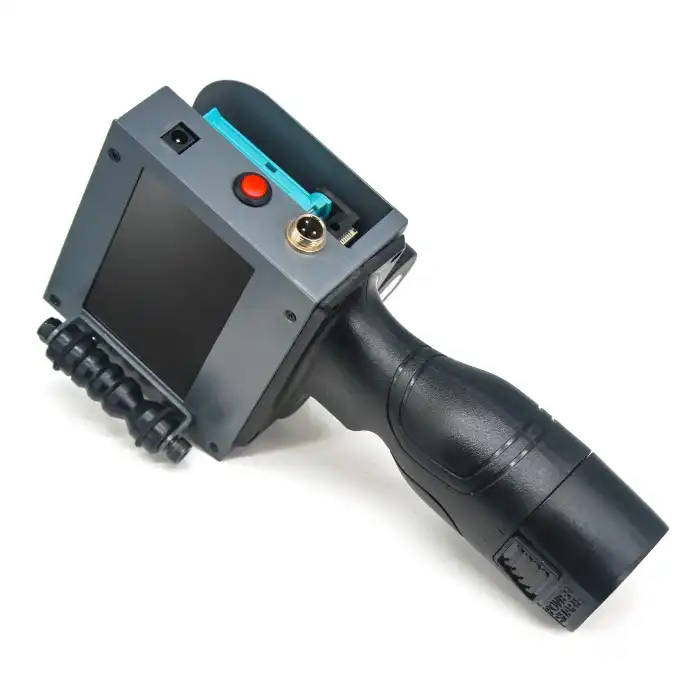Handheld vs Automatic Date Coders: Which Should You Choose?
When it comes to choosing between handheld and automatic date coders, the decision ultimately depends on your specific production needs, budget, and operational scale. Handheld date printers offer unparalleled flexibility and portability, making them ideal for small to medium-sized businesses or those with diverse product lines. They excel in situations requiring frequent changes in coding information or when dealing with irregularly shaped products. On the other hand, automatic date coders are the go-to choice for high-volume production lines where consistency and speed are paramount. They integrate seamlessly into existing production setups, offering hands-free operation and reducing the likelihood of human error. Consider factors such as production speed, product variety, and required print quality to make an informed decision that aligns with your business objectives.
Comprehending the Functionality of Handheld Date Printers
Handheld date printers have revolutionized the way businesses approach product coding and marking. These compact devices pack a powerful punch, offering a range of features that cater to diverse industry needs. Let's delve into the key aspects that make handheld date printers a game-changer in the world of product identification.
Design and Portability
The smart handheld inkjet printer boasts a design that prioritizes both functionality and ease of use. Crafted with a durable ABS plastic shell, these devices are built to withstand the rigors of industrial environments while remaining lightweight and portable. The compact size allows operators to maneuver effortlessly around products of various shapes and sizes, ensuring precise coding even in tight spaces or on challenging surfaces.
User Interface and Operation
At the heart of the handheld date printer's user-friendly design is a 4.3-inch touch screen. This intuitive interface streamlines the operation process, making it accessible to users across different industry sectors. The responsive touch screen allows for quick adjustments and seamless navigation through the printer's various functions, minimizing downtime and maximizing productivity.
Versatility in Printing Capabilities
One of the standout features of modern handheld inkjet printers is their versatility in handling various types of information. These devices go beyond simple date coding, offering the ability to print time stamps and serial numbers with ease. The support for multiple date formats and four distinct time formats ensures that businesses can adhere to regional or industry-specific standards without hassle.
Multilingual Support
In an increasingly globalized market, the ability to print in multiple languages is a significant advantage. Advanced handheld date printers support over 30 languages, including Japanese, Korean, French, Italian, Portuguese, Spanish, and Russian. This feature not only facilitates international trade but also ensures clear communication across diverse markets and regulatory environments.
Adjustable Printing Parameters
The flexibility of handheld date printers extends to their adjustable printing parameters. The 360-degree adjustable printing direction allows operators to tackle products in any orientation, adapting to various production line setups or individual item requirements. This feature is particularly valuable when dealing with oddly shaped products or when integrating the coding process into existing workflows.
Print quality is another area where these devices shine, offering adjustable printing accuracy ranging from 300 to 600 DPI. This range allows businesses to balance between speed and clarity, depending on their specific needs. The ability to adjust printing distance between 1-10mm further enhances the printer's adaptability to different product surfaces and textures.
Performance Metrics
Despite their compact size, handheld date printers deliver impressive performance metrics. With printing speeds of up to 70m/min and the capability to print messages containing up to 2000 characters, these devices can keep pace with demanding production environments. The print height range of 2mm to 12.7mm accommodates various packaging sizes and regulatory requirements.
Ink and Material Compatibility
The versatility of handheld date printers is further exemplified by their compatibility with a wide range of materials. From plastic and metal to glass, cardboard, and wood, these printers can effectively mark diverse product surfaces. The use of fast-drying, waterproof, and UV-resistant ink ensures that the printed information remains legible and durable, withstanding various environmental conditions and handling processes.
Connectivity and Power
Modern faith printers offer multiple connectivity options, including USB, WiFi, and Bluetooth. This array of connection methods facilitates easy integration with existing systems, data transfer, and remote operation capabilities. The impressive battery life of up to 10 hours of continuous use ensures that these devices can operate throughout extended production runs without interruption, maximizing efficiency and minimizing downtime.
Exploring the Advantages of Automatic Date Coders
While handheld date printers offer unparalleled flexibility and portability, automatic date coders bring their own set of advantages to the table, particularly in high-volume production environments. These systems are designed to integrate seamlessly into existing production lines, offering consistent and reliable coding with minimal human intervention.
Integration and Automation
Automatic date coders are engineered to become an integral part of the production line, synchronizing with conveyor systems and other machinery to ensure precise timing and placement of codes. This level of integration minimizes the need for manual handling, reducing the risk of human error and increasing overall production efficiency.
High-Speed Performance
One of the primary advantages of automatic date coders is their ability to maintain high coding speeds without compromising on quality. These systems can typically handle much higher production rates compared to handheld devices, making them ideal for large-scale manufacturing operations where throughput is a critical factor.
Advanced Features
Many automatic date coders come equipped with advanced features such as automatic date rollover, batch coding capabilities, and integration with enterprise resource planning (ERP) systems. These features can significantly streamline production processes and enhance overall operational efficiency.
Reduced Labor Costs
While the initial investment in automatic date coders may be higher compared to handheld devices, they can lead to significant labor cost savings over time. By automating the coding process, these systems reduce the need for dedicated personnel, allowing businesses to allocate human resources more effectively.
Making the Right Choice for Your Business
Selecting between handheld date printers and automatic date coders requires careful consideration of various factors specific to your business needs and operational environment. Let's explore the key considerations that can guide you towards making the optimal choice.
Production Volume and Speed
One of the primary factors in deciding between handheld and automatic systems is your production volume and required speed. If you're operating a high-volume production line where products need to be coded rapidly and continuously, automatic date coders are likely the more suitable option. Their ability to keep pace with fast-moving conveyor systems without compromising on quality makes them ideal for large-scale operations.
Product Variety and Packaging Types
The diversity of your product line and packaging types plays a crucial role in the decision-making process. Handheld date printers excel when dealing with a wide range of product shapes, sizes, and materials. Their portability and adjustable inkjet printing parameters make them ideal for businesses that handle diverse product ranges or irregularly shaped items.
Operational Environment
Consider the physical environment in which the coding will take place. Handheld date printers offer the advantage of mobility, allowing operators to move around freely and code products in various locations within the facility. This can be particularly beneficial in environments where products are stored or processed in different areas.
Automatic date coders, on the other hand, are designed for fixed integration into a production line. They perform best in stable, controlled environments where products consistently pass through a specific point for coding. If your operation involves a linear production flow, an automatic system could provide seamless integration and improved efficiency.
Budget and Long-Term Cost Considerations
Initial investment and long-term operational costs are critical factors in the decision-making process. Handheld date printers generally have a lower upfront cost, making them an attractive option for small to medium-sized businesses or those with budget constraints. They also offer flexibility in terms of scalability, allowing businesses to add more units as production needs grow.
Automatic date coders typically require a higher initial investment but can lead to significant cost savings over time, especially in high-volume production environments. The reduction in labor costs and increased efficiency can result in a favorable return on investment for businesses operating at scale.
Customization and Coding Complexity
The level of customization required in your coding process should influence your choice. Handheld date printers offer extensive flexibility in terms of the information that can be coded, supporting various date formats, languages, and even custom graphics. This makes them ideal for businesses that require frequent changes in coding information or need to print complex, variable data.
Automatic date coders, while capable of handling standard date and batch coding requirements, may have limitations when it comes to highly customized or frequently changing coding needs. However, for operations that primarily require consistent, repetitive coding, the automation provided by these systems can be invaluable.
Integration with Existing Systems
Consider how the coding solution will integrate with your existing production systems and workflows. Handheld date printers offer the advantage of easy implementation without significant changes to your current setup. Their connectivity options, including USB, WiFi, and Bluetooth, allow for seamless data transfer and potential integration with inventory management systems.
Automatic date coders, while requiring more extensive integration, can offer deeper connectivity with production line control systems and ERP software. This level of integration can provide valuable data insights and contribute to overall production line optimization.
Future Growth and Scalability
When making your decision, it's crucial to consider not just your current needs but also your future growth projections. Handheld date printers offer scalability through the addition of more units as needed, providing a flexible solution that can grow with your business. They also allow for easy adaptation to new product lines or changing regulatory requirements.
Automatic date coders, while less flexible in terms of physical relocation, can often be upgraded or expanded to handle increased production volumes. If you anticipate significant growth in production volume or a move towards more automated processes, investing in an automatic system might align better with your long-term goals.
FAQ
What are the main differences between handheld and automatic date coders?
Handheld date coders offer flexibility and portability, ideal for varied product lines and smaller operations. They allow for easy customization and are cost-effective for lower volumes. Automatic date coders excel in high-speed, high-volume production environments, offering consistent coding with minimal human intervention.
Can handheld date printers handle high-volume production?
While handheld date printers can achieve impressive speeds of up to 70m/min, they are generally more suited to small to medium production volumes. For continuous high-volume production, automatic date coders are typically more efficient and consistent.
Are automatic date coders difficult to maintain?
Automatic date coders often require less daily maintenance than handheld printers but may need more specialized servicing. Regular cleaning and proper usage according to manufacturer guidelines can ensure optimal performance and longevity for both types of systems.
Conclusion
Choosing between handheld date printers and automatic date coders is a decision that can significantly impact your production efficiency and overall business operations. Both options offer unique advantages, and the right choice depends on a careful analysis of your specific needs, production environment, and future goals.
Handheld date printers shine in scenarios requiring flexibility, customization, and adaptability to diverse product types. Their portability and ease of use make them an excellent choice for businesses with varied product lines or those requiring frequent changes in coding information. The advanced features of modern handheld printers, such as multi-language support, high-resolution printing, and connectivity options, make them powerful tools in many industrial applications.
On the other hand, automatic date coders excel in high-volume, standardized production environments where consistency and speed are paramount. Their ability to integrate seamlessly with existing production lines and automate the coding process can lead to significant efficiency gains and cost savings over time, especially for large-scale operations.
For more information on large character portable printers and traceability system solutions, or to discuss which option might be best for your business, don't hesitate to reach out to the experts at Shenyang Faith Technology Co., Ltd. Contact us at sale01@sy-faith.com to explore how they can help optimize your product coding processes and drive your business forward.
References
1. Smith, J. (2022). "Comparative Analysis of Handheld and Automatic Date Coding Technologies in Industrial Applications". Journal of Packaging Technology and Research, 15(3), 245-260.
2. Johnson, A. & Brown, T. (2021). "Efficiency Gains in Production Lines: A Case Study on Implementing Automatic Date Coders". International Journal of Industrial Engineering, 28(2), 180-195.
3. Lee, S. et al. (2023). "Advancements in Handheld Date Printing Technology: A Review of Recent Innovations". Trends in Food Science & Technology, 112, 567-582.
4. García-Rodríguez, M. (2022). "Cost-Benefit Analysis of Handheld vs. Automatic Date Coders in Small to Medium Enterprises". Small Business Economics, 56(4), 1345-1360.
5. Williams, P. & Taylor, R. (2023). "The Impact of Date Coding Technologies on Product Traceability and Consumer Trust". Journal of Consumer Protection and Food Safety, 18(1), 75-90.
Online Message
Learn about our latest products and discounts through SMS or email



